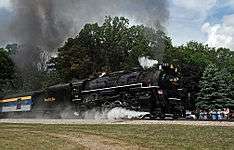Berkshire locomotive
The Class A-1 Berkshire locomotive is a 2-8-4 steam locomotive first built in 1925 by the Lima Locomotive Works. The design was initially intended to improve on the company's USRA Mikado design (2-8-2), which was deemed to lack sufficient speed and horsepower. This was addressed by the inclusion of a larger, 100-square-foot (9.3 m2) firebox that required an extra trailing axle, giving the locomotive its distinctive 2-8-4 wheel arrangement.

The Berkshire locomotive was so named for its testing location on the Berkshire Hills of the Boston & Albany Railroad. After the Class A-1 successfully outperformed a Class H-10 Mikado, the Boston & Albany Railroad became the first to order the new Berkshires. Over 600 were built by the Lima Locomotive Works, the American Locomotive Company, and Baldwin Locomotive Works. A total of nineteen different railroads purchased Berkshires, including the Erie Railroad, who owned 105 Berkshires, more than any other railroad; the Chesapeake & Ohio Railway, who nicknamed theirs the Kanawhas; and the Louisville & Nashville Railroad's, whose locomotives were technically designated as Class M-1 but were referred to as "Big Emmas".